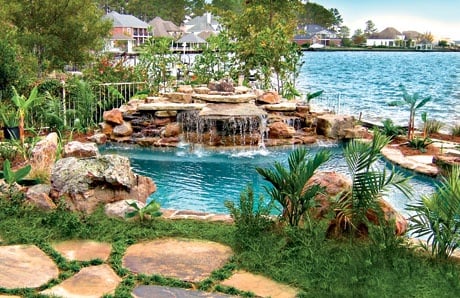Determining if a Natural Swimming Pool is Right For You
Part 1 of 2
Natural swimming pools are the true realization of a healthy, environmentally friendly backyard resort. Not only does a natural pool look beautiful and seamlessly blend into its surroundings, it boasts special design, materials, and equipment that maintain the water without chemicals. That’s right, zero chlorine!To achieve swim-ready water in an organic fashion, natural pools are patterned after the ecosystems in lakes and ponds. In what’s called a regeneration zone, they create a virtual wetland with a mix of aquatic plants, rock and gravel that attract friendly microbes, special filtration, and disinfection systems. These elements form an ecosystem that functions like a miniature water-treatment plant, cleaning the water and then pumping it back into the main pool.
This regeneration zone is constructed as a distinct section of the pool. In some cases, it is built as an entirely separate vessel adjacent to the main pool. In either case, the zone is dedicated to the plant life ecosystem; people cannot swim in it.

With their gorgeous looks and chemical-free swimming environment, what’s not to love about natural swimming pools? As desirable as they are, natural pools have special requirements and limitations. Here are five key questions that pose practical challenges for many homeowners considering a natural pool:
1. Do you have the needed backyard space?
Just how big is your backyard and how much of it are you willing to devote to a pool? With a natural pool, the regeneration zone must be separate from the main pool, and that eats up about one half of the pool. For example, if you want a pool that’s 700 square feet, you will need a separate section or secondary pool roughly the same size. Make this calculation and if your real estate is too tight then you can rule out a natural pool (unless you are willing to settle for a really small one).2. How much extra is in your budget for a boutique pool installation?
Natural pools are rare in the U.S. and are a true specialty project. Some claim that their cost per square foot is the same as a traditional pool. However, when you remember that your natural pool area (with regeneration zone) needs to be roughly double the size of the pool you want for actual swimmer use, the math does not pencil out: The total cost of a natural pool will run higher than that of a traditional one. And you can almost certainly forget about getting more than one estimate on a natural pool; there are very, very few U.S. markets with a single company building this unique kind of project—let alone two.
3. Will your family members enjoy swimming in pond-like water?
With natural pools, you need to consider the appearance of the water—and what’s in it. It looks like the water in a pond. Sometimes it will be relatively clear, but there will be varying levels of algae and sediment present. Levels will vary with conditions like heat, rain, and seasonal changes that affect the plant life and microorganisms. For some homeowners, organic-looking water is appealing and part of the unique beauty of a natural pool. However, if you like a traditional pool’s crystal-clear water glistening against a white or blue interior finish, then a natural pool’s water may disappoint you.
4. What style do you envision for your new pool?
If you seek a pool that will mimic the look of a pond or lake in your backyard and if you have a tropical or woodsy setting then a natural pool can be an excellent choice. However, certain pool styles and materials do not inherently fit well in a natural pool. For example, a modern design with clean lines, glass tile accents, and sleek cascade water features are not a great match for a natural pool. There are clever ways to achieve some degree of contemporary style in a natural pool. However, the aesthetic hurdles and construction costs typically increase and there are limits to what a builder can successfully pull off.
5. Are you planning a spa with your pool?
Roughly half of all traditional custom pools are built with an attached spa, based on the experience of Blue Haven offices around the country. Spas are popular because they bring another dimension to the pool. They offer relaxing hydrotherapy and a more comfortable environment for children and those who cannot yet swim. Spas also extend pool season as owners can enjoy warm, bubbly water even in cooler weather. However, due to the special manner in which a natural pool is constructed and how it maintains the water, an attached spa is simply not practical. You can purchase a stand-alone, factory-made hot tub, and then have your builder integrate it (to some degree) with the overall poolscape, but expect this to add significant cost to your project.If you are fortunate enough to have the right backyard, budget, style preferences, and proximity to the rare builder of natural pools, then this kind of pool can be a stunning addition to your home and create a healthy escape for your family.
If any of these factors do not fit with your circumstances, but you still want a natural-looking pool—without the typical chlorine hassles and hazards—there is good news: An alternative exists: a traditional pool specifically designed and equipped to provide similar benefits of a natural pool. Best of all, it can work for most backyards and pool budgets. In part 2 next week, we will explain more about a practical, attractive, virtually chlorine-free alternative to natural swimming pools.




.jpg?width=1490&name=rock-waterfall-slide-pool%20(1).jpg)